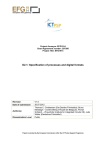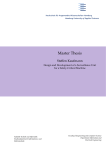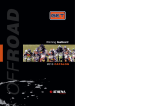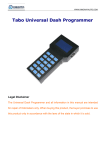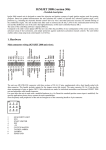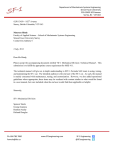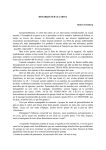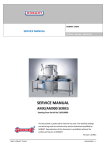Download 3 Flowchart
Transcript
CONTENTS 1 What is required for suspensions ........................................................................ 1 1-1 Requirements for street use ....................................................................................... 1 1-2 Requirements for racing use ...................................................................................... 1 2 How to set up ......................................................................................................... 2 2-1 Diagnosis of symptoms .............................................................................................. 2 2-2 Clarification of questionable points ............................................................................ 2 2-3 Setup procedure ......................................................................................................... 3 3 Flowchart ................................................................................................................ 4 3-1 Breaking ..................................................................................................................... 4 3-2 Turn ............................................................................................................................ 5 3-3 Automatic turning of front handle toward inside ......................................................... 6 3-4 Chattering ................................................................................................................... 8 Reference .................................................................................................................. 10 CAUTION This guidebook only introduces general ideas about suspensions. There may be some phenomena that are not consistent with the description in this guidebook. We assume no responsibility for any accident, damage, injury or trouble caused by a macine which was set up with this guidebook as a reference. Judge anything at your own risk. Ask an expert if you have any question and proceed with setup carefully after making everything clear. What is required for suspensions 1 What is required for suspensions YZF-R1 & R6 is commercially available for street use only. Requirements for street use and requirements for racing use to run in circuit course quicker are different, though. It is important to understand phenomenon peculiar to racing use when you want a machine dedicated to racing use in order to raise potential of the machine by adjusting its feature accordingly. 1-1 Requirements for street use • Two seats • Running over bumps such as unevenness of road and temporary road under construction (comfort, etc.) • Resistance to impact including external input under unexpected circumstances during normal running Machines for street use have setup to meet operational stability, comfort and durability under such use conditions. Spring rate, preload of spring and front fork leg oil level are important elements for setup of front forks. They incorporate mechanism (oil lock) to deal with accidental heavy load and to block internal oil path around maximum stroke so that end of suspension will not contact the bottom to avoid unstable behavior of a machine in case of unexpected disturbance and to prevent damage of the suspension itself in addition to secure comport and stability during fast run. Bumper rubbers installed to the suspension rod work for rear tires in a manner similar to the mechanism mentioned above. 1-2 Requirements for racing use • Hard braking enabled by high braking capacity • Increased lean angle during turning enabled by high-grip tires • Control ability when a tire is sliding • Ability to follow road surface when there are gaps (securing ground contact load of tires) Circuit use needs much higher stability requirements of whole chassis as mentioned above. Suspension setup suitable for a course, lap time and tires to be used can raise the possibility of shortening lap time. Spring load is the most important setup element of suspension for racing as it is for street use. However, previously-mentioned setup for street use can cause difficulty of operation for racing use. Some examples are as follows. Soft spring rate for comfortable riding can cause too much movement of a machine due to fore-aft movement of load. In case of too high load setup in deep stroke range, the entire suspension stroke may not be used smoothly to make you feel stiffness (tightness) when stroke exceeds certain point. It is necessary to change spring reaction force (spring rate, preload and front fork leg oil level, in this case) and characteristic of damping force to control amount of load movement and speed during braking or accelerating so that appropriate machine attitude can be attained as necessary to solve these problems under such limited use conditions (stable road surface condition like a circuit course). Front and rear tires can attain maximum holding force to realize smoother riding characteristic by performing such setup correctly. The KIT suspension aims to increase performance on a circuit course taking into consideration such elements. -1- How to setup 2 How to setup 2-1 Diagnosis of symptoms [Figure 1: Under spring] [Figure 2: Over spring] As shown in the figure 1, suspension stroke speed under springs is important when you want to improve ability to follow uneven surface. Front and rear wheels basically move up and down to an appropriate degree compared to the chassis to absorb impact. The suspension works at high speed under such conditions. Acceleration and braking are continually repeated when running machine in circuit in most cases. It may well to think that the whole machine as well as rider makes pitching movement to and fro as shown in figure 2, not that the wheels move up and down on such surface. What is important for setting up suspension of machine for racing is: “How far you makes pitching movement at what speed?” Tires contacting surface also play an important role, in fact, and tire pressure must be also considered during setup. 2-2 Clarification of questionable points It is necessary to judge phenomena of riding condition as specifically as possible when setting up racing suspension for a circuit. In case of “bad turning”, for example, is the turning bad when you start turning before a corner (with throttle off and starting to lean) or when you are turning with large leaning angle? Were you starting to open the throttle or closing it? Was the turning bad when you were accelerating after turning is almost exit the corner? There are many ways of trying setups appropriate for a situation. Predict causes by diagnosing symptoms and try several ways to narrow down the cause and solve problems. It is a given fact that all parts work correctly to follow the above procedure. Therefore, adjust setup after checking the tightening torque of each part and operation under no load if any trouble is suspected. -2- How to setup 2-3 Setup procedure Narrow down appropriate value for machine posture under necessary conditions (braking and cornering) by adjusting spring rate and preload basically. They vary depending on riding style, course, lap time or the like. Narrow down the cause by diagnosing symptoms referring to remaining amount of suspension stroke, etc., adjust machine posture to supposable conditions based on diagnosis and find out appropriate spring load balance for front and rear suspensions. Proceed with setup referring to the following flowchart while taking into consideration the symptoms and phenomena you experienced while driving as well as current setup. * Point • It is possible to attain fine adjustment value of 0.925N/mm for an optional spring of front fork by installing a spring of 0.9 N/mm at one side and a spring of 0.95 N/mm at the other side, for example. • Air spring characteristics associated with front fork leg oil level can harm spring characteristic of target spring and should not be higher than standard setup of KIT more than is necessary. (Minimum oil level = R1: 180 mm R6 : 160 mm) -3- Flowchart 3 Flowchart This section describes typical symptoms of breaking, turning, automatic turning of front handle toward inside and chattering as well as their countermeasures. Find the best suspension setup referring to the description. 3-1 Breaking * Point Adjust engine brake using YMS first to adjust sliding of rear tire during braking. Phenomenon: Unstable breaking (sliding of rear tire) Countermeasure Check item Is engine brake control sufficient? NO GOOD Change YMS map. GOOD If the problem is not still solved Countermeasure Adjust engine brake using slipper clutch. (Check regulation of the race to be entered.) Countermeasure Check item Is not front fork stroke too large? NO GOOD GOOD Countermeasure Check item Is rear machine height too large? Increase front preload or increase spring rate. Decrease the projecting length of the front fork (lifted front portion) Increase front compression. NO GOOD -4- Decrease rear machine height. Flowchart 3-2 Turn Phenomenon: Bad turning performance A. When leaning angle (It is hard to move to inside) Countermeasure Increase front preload or spring rate. Decrease the projecting length of the front fork. (Lifted front portion) Increase front compression. Large stroke Check item Front fork stroke Countermeasure Decrease front preload or spring rate. Increase the projecting length of the front fork. (Lowered front portion) Decrease front compression. Small stroke * Point Make the stroke amount of the front fork appropriate. B. During steady turning Countermeasure Throttle on or brake off Check item Increase rear preload. Increase rear compression. Increase front rebound. Increase rear machine height. Throttle and brake operation Countermeasure Throttle off or brake on Decrease front preload. Increase rear machine height. * Point Make the stroke amount of the front and rear suspensions appropriate. C. When rising up Countermeasure Check item Throttle operation Almost or wide open Increase rear preload or spring rate. Increase rear compression. Increase front rebound. Decrease the projecting length of the front fork. (Lowered front portion) * Point Make the stroke amount of the rear suspension appropriate. -5- Flowchart 3-3 Automatic turning of front handle toward inside Phenomenon: Steering handle is turned inside when turning (Too much steering angle compared to lean angle) A. When throttle is off Countermeasure Check item Is not there abrasion (rough surface) on the front tire? * Too much stress is applied partially. NO GOOD Increase or decrease air pressure of the front tire. GOOD Check item Check item Is not projecting length of the front fork larger than standard (STD) value? (Is not the front portion too low?) NO GOOD Decrease projecting length of the front fork. (Lifted front portion) GOOD Check item Check item Is the stroke amount of the front fork appropriate? NO GOOD In case of too much stroke Increase front preload or spring rate. GOOD In case of too small stroke Decrease front preload or spring rate. Check item Check item Is not rear stroke too large? NO GOOD Increase rear preload or spring rate. GOOD Check item Check item Is rear machine height too large? NO GOOD -6- Decrease rear machine height. Flowchart B. When throttle is on Countermeasure Check item Is not the projecting length of the front fork larger than standard (STD) value? (Is not the front portion too low?) NO GOOD Decrease the projecting length of the front fork. (Lowered front portion) GOOD Countermeasure Check item Is not rear stroke amount too large? NO GOOD Increase rear preload or spring rate. GOOD Countermeasure Check item Is rear machine height too small? NO GOOD -7- Increase rear machine height. Flowchart 3-4 Chattering Chattering (small vibration) is often caused by various elements interacting with each other. It is believed that chattering is caused due to combination of various elements such as compatibility of tire and chassis, problems related to wheel and brake parts, etc. You have to check element by element because you may feel vibration at front portion even if the cause lies in rear part. The suspension setup aims to decrease chattering. Check if the chassis is working normal to locate the cause. • Rattle of parts around the steering head pipe and operation of the front fork • Rattle of parts around the rear swing arm and operation of the rear suspension • Tightening torque of front fork, rear swing arm pivot, etc. (Is not torque too large?) • Roundness and static balance of tires and wheels • Damage to the wheel bearing and inner spacer • Wear of drive system including driven sprocket hub damper Adjust, repair or replace parts following instructions of service manual if there is any problem in items above. A. Problem occurs on straight course Symptom Countermeasure Problem depends on speed regardless of location. Check static balance and roundness of wheels and tires B. Problem occurs on right or left corner only Symptom Countermeasure Problem occurs when lean angle is large. Check runout of wheels and tires C. Problem occurs when leaning angle (including large lean angle) at the beginning of a corner Phenomenon Vibration from the front portion Countermeasure Check item Is not remaining stroke of the front fork too large? NO GOOD GOOD Countermeasure Increase or decrease air pressure by up to 20 kPa. -8- Increase front preload. Decrease front compression. Decrease front rebound. Flowchart D. Problem occurs when leaning angle (with throttle off) at the beginning of a corner Symptom Countermeasure Vibration from the rear portion Countermeasure: Increase engine brake control. Increase or decrease air pressure by up to 20 kPa. Decrease rear compression. Decrease rear rebound. E. Problem occurs when exiting corner Symptom Pumping (periodical vertical movement) of rear portion Countermeasure Check item Is not remaining stroke of rear suspension too large? NO GOOD -9- Increase rear preload. Increase spring rate. Decrease rear rebound. Decrease rear compression. Reference Reference Front and rear load changes and front and rear suspension movement in different scenarios. Accelerating . Load change The wider the throttle is opened, the more the load is concentrated on the rear. . Front fork Reaches nearly maximum extended stroke. . Rear cushion Up to 20 to 30mm stroke displacement, depending on conditions. Braking . Load change The harder the brake is applied, the more the load is concentrated on the front. . Front fork Displaces until stroke has almost bottomed. . Rear cushion Reaches nearly maximum extended stroke. Cornering . Load change Increases the load on the front fork and rear cushion on both sides. . Front fork Up to 30 to 90mm stroke displacement depending on the size of the corner. . Rear cushion Up to 25 to 40mm stroke displacement, depending on conditions. - 10 - Published by YAMAHA MOTOR ENGINEERING co., LTD















